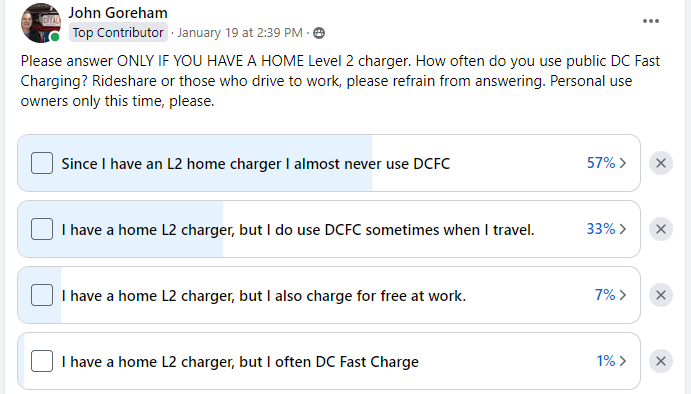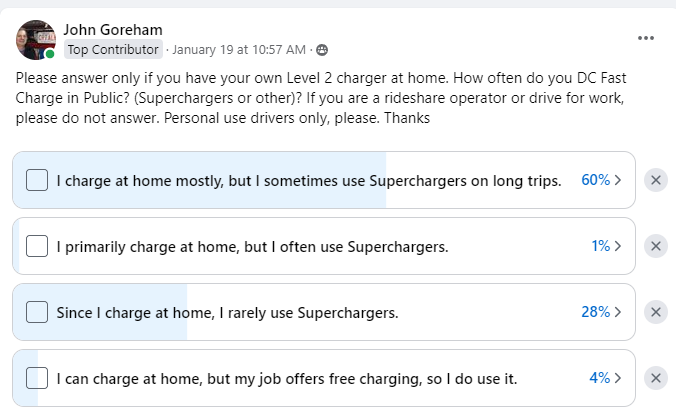Charging a battery-electric vehicle (BEV) in public is a hassle. The two main gripes are that the direct current fast chargers are often overcrowded and often broken. This endangers the future of EV adoption. Both of these problems are very simple to resolve today, and it would cost the taxpayers nothing.
Before we begin, we need to address an issue that nobody likes to talk about. The issue is that the public chargers that are being complained about are being primarily used by EV owners who don't have the ability to charge their vehicles at home. How do we know? We asked EV owner/members of two popular social media groups.
We started with the top-selling affordable EV, the Chevy Bolt. We polled over 20,000 members, and hundreds answered the poll question. You can see the result for yourself here. We have run polls like this many times in the past. Most EV owners charge most of the time at home.

Next up, we asked 46,500 members of a group representing the top-selling EV overall in America, the Tesla Model Y. As you can see, even Tesla owners, who have access to the very best fast charging network in the world, mostly charge at home.

Most EV owners presently charge at home most of the time. Could it be that the main issue is DCFC “superusers” clogging up the public chargers? Perhaps rideshare operators and BEV owners without a home charger? Everyone associated with the EV world knows, and often says, that the old gas pump model won’t work with EVs. So, why are trying to do what we all know won’t work?
The best way to make DCFCs available to the majority of owners who may indeed be far from home on a road trip is to ensure that they are available and working. Here are the best two ways to do that.
Solve DCFC Problems Step One - Make Public Charging Ridiculously Expensive
If you want to shorten lines at a DCFC, make the cost so high that BEV owners will only use it when other options are not available. Today, DCFC use is already very expensive. The going rate is often around $0.50/kWh. At that rate, it is much more affordable to power a hybrid or a plug-in hybrid than a battery-electric vehicle. In fact, in many areas, it is more affordable to power a liquid-fueled vehicle.
We currently have a situation where public fast charging is expensive. The solution to our overcrowding problem at DCFCs is to make the charging much much more expensive. Perhaps $2.00/kWh? If we do this, BEV owners will make darn sure not to use DCFCs on a daily basis. They will charge at home, where it is cost-effective. If they cannot charge at home, perhaps they will instead use another green transportation option?
Solve DCFC Problems Step Two - Provide Limited Free Fast Charges With Membership
Most EV owners will occasionally use a DC fast charger when they travel. It’s not fair to punish BEV owners who have responsibly set up a home charger that they primarily use to charge their EV. So, the simple solution to allow these owners to DC fast charge when they are on the road away from the radius of their own charger is to let them charge for free. No cost at all. This can be accomplished easily. Simply provide a few free charging sessions with each membership to a given charger company that an EV owner has. Again, limited free charging is already a thing. Nearly every new EV comes with a limited free charging program. We need not reinvent the wheel here.
Summary - All the Public DCFC Charger Problems Go Away When Pubic Charging Is VERY Expensive
Today, charging companies are not making much money. They really don't care if you charge using their products or not. Heck, VW’s charger network is a punishment for cheating on emissions. If you want chargers to have better up-time and not be broken so often, make them very profitable for the companies that own and operate them. If we want them to be available, simply make the cost so high that EV owners will adapt and not use them unless they are on a road trip - in which case the cost is zero.
Public chargers are overcrowded because BEV owners with no home chargers and ride-share operators are using them like gas pumps. Nobody thinks the solution to EV charging is to try to replicate the old gas pump model. So, let’s stop trying.
Image of Chevy Bolt charging at an EVGo station by John Goreham.
John Goreham is an experienced New England Motor Press Association member and expert vehicle tester. John completed an engineering program with a focus on electric vehicles, followed by two decades of work in high-tech, biopharma, and the automotive supply chain before becoming a news contributor. In addition to his eleven years of work at Torque News, John has published thousands of articles and reviews at American news outlets. He is known for offering unfiltered opinions on vehicle topics. You can follow John on Twitter, and connect with him at Linkedin.











